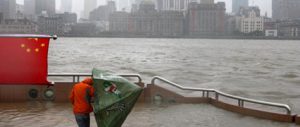The recent floods in Yuyao, Zhejiang province, are an urgent reminder of the need for effective flood control in China. Every year since 2008 at least 130 Chinese cities have suffered flooding. Most cases are due to flood waters running off hillsides after downpours, or poor drainage. A rising incidence of urban flooding is linked to localised increases in precipitation caused by climate change – but more important are the increased risks of flooding brought by urbanisation.
Housing, water supply, electricity, gas, transportation, communications and sewage are the most urgent issues during urbanisation. And as these can be charged for, market mechanisms can be used to pay for them, which means faster development. But rainwater drainage lags behind: it is very costly and as it is a public good the government has to take the lead. The problem is that it cannot recover costs, and decision-makers will not spend money to mitigate floods that may not happen while they are in power.
In developed nations with greater experience of urbanisation and industrialisation there are better rules and procedures for building new city districts: land can only be sold once the government has put sub-surface infrastructure in place. This creates an ‘underground first’ approach.
But China’s extraordinary pace of urbanisation means that local governments have to sell land to fund development and their own operations – and low-lying flood-prone land is the most popular with developers. Given that it’s usually more sparsely populated, the costs of resettling existing residents are lower, and so the return on investment is faster.
The risks of flooding are particularly apparent as the wave of urbanisation moves inland from the coastal cities: the density of people and property in at risk areas is increasing. Expanding cities mean more run-off from impermeable surfaces, and a higher risk of flooding, even if precipitation does not increase.
With drainage systems placed under much higher burdens, the inability of urban waterways to absorb floodwaters becomes more apparent. For these reasons, China will see worsening urban floods. Only when improvements in measures to prevent floods and reduce waterlogging outstrip the increase in flood risks of urbanisation will this trend stop.
Chinese cities face wait for improvement
Other Asian countries, such as Japan and Korea, have already seen rapid urbanisation and suffered the same problems. Their first response was also to increase drainage, but they found that when rainwater was collected and channelled to the rivers flood peaks came higher and earlier, making flood prevention more difficult.
In the mid-1970s Japan stopped trying to immediately channel rainwater to the rivers, formulating instead a comprehensive plan including:
1) Identifying and publishing maps of flood-prone areas;
2) Identifying soil and water conservation areas, retention basins, and low-lying areas likely to flood, with different control measures to be taken for each;
3) Using open land and retention basins, flood control ponds, rainwater storage and permeable surfaces; rebuilding sewers to allow for more water retention, protecting natural water retention during urban expansion, and encouraging residents to store rainwater and use raised-floor foundations;
4) Methods of land use and construction which take flood safety into account, including identifying areas at risk and working with residents. Subsequently flood control ponds and pipes were made more permeable, reducing the burden on the system and also helping to replenish groundwater.
Despite the huge construction, operation and maintenance costs, Tokyo has also built a 6.3km-long system of tunnels as a last resort to deal with localised flooding – a project which cost the equivalent of 19 billion yuan and took from 1992 to 2006 to complete. The pumps at the outlet bring water from a tank 60 meters below ground and dump it into the Edo River.
All of this will take a long time – it took 30 years of sustained effort to improve things in Japanese and Korean cities. But at least the Chinese government is starting to work on urban flooding. The State Council has ordered that by 2015 flood prevention measures in key cities must be up to national standards, and that over the next ten years there will be a comprehensive upgrade of urban drainage and flood prevention.





